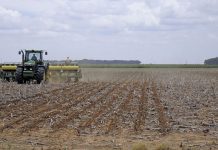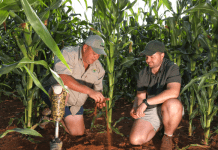Bacterial speck (psuedomonas syringae) is widespread throughout SA at certain times of the year. It’s a cool weather bacteria and thus suppressed when temperatures exceed 21ºC, and also requires moist conditions. It may therefore start on a crop and then virtually disappear when conditions become too uncomfortable. Conversely, it can reappear if conditions become favourable again, though this happens less often.
The bacteria can develop on a number of weeds. It can also be introduced through infected seed, but this is becoming rare nowadays, when expensive hybrid seed is produced under far more hygienic conditions than the cheap, open-pollinated seed of the past. Be very careful in the nursery to ensure plants are well-sprayed, as the disease can spread rapidly under these conditions and becomes substantially more destructive when infected at the seedling stage.
Bacterial speck (Xanthomonas campestris) causes dark brown spots of 1mm to 2mm to develop on the leaves. They’re usually around 1mm and often, but not always, concentrated near the leaf margins. yellowish halo around these spots is common for bacterial diseases. On the stems, spots can become more elongated. On fruit the symptoms are small, dark spots. A similar disease, bacterial spot, also causes larger spots to develop.
These are easily distinguished on the fruit, where they resemble small craters. Prevention by spraying C heck newly planted stands frequently for symptoms, especially when transplanting during cool weather in spring. Plants are generally much healthier at this stage and it’s very easy to drive past the land and feel everything is in order, only to discover later that the disease has become established. atching and treating it early will make a huge difference to yield potential and cost of control. The plants have to be thoroughly sprayed, wetting under the leaves too, which isn’t all that easy when they’re so near the ground. Much less spray is used on small plants so one can afford to be generous.
Nipping the disease in the bud at this stage will be more than rewarded by saving spraying costs later on, so spray at the first sign of spots. I t doesn’t matter if there’s confusion about whether it’s a bacterial spot, speck or a fungus. The remedy is copper and this will work for all – it won’t kill off the bacteria which have already infected the tissue, but will protect the plant from further infection. Keep applying it until the weather changes and the symptoms stop. – Bill Kerr Contact Bill Kerr on (016) 366 0616 or e-mail [email protected]. |fw








